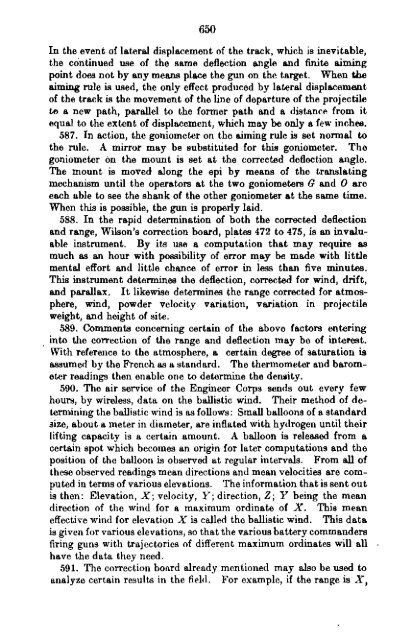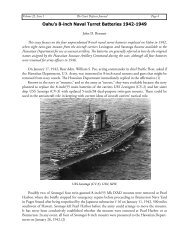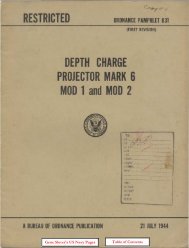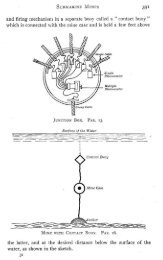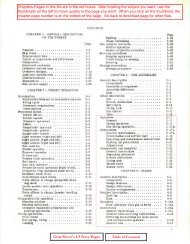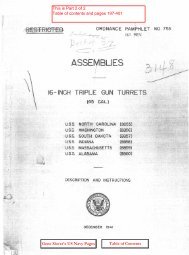...Railway artillery - Personal Page of GENE SLOVER
...Railway artillery - Personal Page of GENE SLOVER
...Railway artillery - Personal Page of GENE SLOVER
Create successful ePaper yourself
Turn your PDF publications into a flip-book with our unique Google optimized e-Paper software.
650<br />
In the event <strong>of</strong> lateral displacement <strong>of</strong> the track, which is inevitable,<br />
the continued use <strong>of</strong> the same deflection angle and .finite aiming<br />
point does not by any means place the gun on the target. When the<br />
aiming rule is used, the only effect produced by lateral displacement<br />
<strong>of</strong> the track is the movement <strong>of</strong> the line <strong>of</strong> departure <strong>of</strong> the projectile<br />
te a new path, parallel to the former path and a distance from it<br />
equal to the extent <strong>of</strong> displacement, which may be only a few inches.<br />
587. In action, the goniometer on the aiming rule is set normal to<br />
the rule. A mirror may be substituted for this goniometer. The<br />
goniometer on the mount is set at the corrected deflection angle.<br />
The mount is moved along the epi by means <strong>of</strong> the translating<br />
mechanism until the operators at the two goniometers G and 0 are<br />
each able to see the shank <strong>of</strong> the other goniometer at the same time.<br />
When this is possible, the gun is properly laid.<br />
588. In the rapid determination <strong>of</strong> both the corrected deflection<br />
and range, Wilson's correction board, plates 472 to 475, is an invaluable<br />
instrument. By its use a computation that may require as<br />
much as an hour with possibility <strong>of</strong> error m,ay be made with little<br />
mental effort and little chance <strong>of</strong> error in less than five minutes.<br />
This instrument determines the deflection, corrected for wind, drift,<br />
and parallax. It likewise determines the range corrected for atmosphere,<br />
wind, powder velocity variation, variation in projectile<br />
weight, and height <strong>of</strong> site.<br />
589. Comments concerning certain <strong>of</strong> the above factors entering<br />
, into the correction <strong>of</strong> the range and deflection may be <strong>of</strong> interest.<br />
With reference to the atmosphere, a certain degree <strong>of</strong> saturation is<br />
assumed by the French as a standard. The thermometer and barometer<br />
readings then enable one to determine the delUlity. .<br />
590. The air service <strong>of</strong> the Engineer Corps sends out every few<br />
hours, by wireless, data on the ballistic wind. Their method <strong>of</strong> determining<br />
the ballistic wind is as follows: Small balloons <strong>of</strong> a standard<br />
size, about a meter in diameter, are inflated with hydrogen until their<br />
lifting capacity is a certain amount. A balloon is released from a<br />
certain spot which becomes an origin for later computations and the<br />
position <strong>of</strong> the balloon is observed at regular intervals. From all <strong>of</strong><br />
these observed readings mean directions and mean velocities are computed<br />
in terms <strong>of</strong> various elevations. The information that is sent out<br />
is then: Elevation, X; velocity, Y; direction, Zj Y being the mean<br />
direction <strong>of</strong> the wind for a maximum ordinate <strong>of</strong> X. This mean<br />
effective wind for elevation X is called the ballistic wind. This data<br />
is given for various elevations, so that the various battery commanders<br />
firing guns with trajectories <strong>of</strong> different maximum ordinates will all<br />
have the data they need.<br />
591. The correction board already mentioned may also be used to<br />
analyze certain results in the field. For example, if the range is X,<br />
Digitized by Coogle


